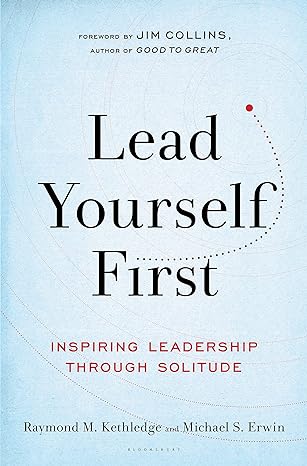
Lead Yourself First: Inspiring Leadership Through Solitude - By Raymond M. Kethledge & Michael S. Erwin
Date read: 2018-06-02How strongly I recommend it: 6/10
(See my list of 150+ books, for more.)
Go to the Amazon page for details and reviews.
This is one of those books that was a great blog post or magazine article that they tried to turn into a book. Good advice for leaders to practice solitude, but not all of the examples are relevant to the main point of the book. Still, some useful management theories and quotes.
My Notes
To lead others, you must first lead yourself.
Leadership, as Dwight Eisenhower defined it, is “the art of getting someone else to do something that you want done because he wants to do it.”
Solitude offers ways for leaders to obtain greater clarity.
A critical element of effective leadership is not to let the immediate take precedence over the important.
Analytical clarity does not always allow the leader to know which decision is best. But it does allow the leader to focus, clearly and specifically, on the key variable that will determine whether a decision brings success or failure.
“One day a man came to the monk for advice. He started talking about all the problems in his life. The monk started pouring a cup of tea. The man kept talking, the monk kept pouring. The tea overflowed out of the cup, onto the table, onto the floor. The man said, ‘Stop—what are you doing?’ The monk replied, “Don’t you see? This is you.’
Viktor Frankl wrote about how between every stimulus and response, there is a space. Silence and solitude creates a sacred space, an elongated space. The space gives you time to develop a creative response to what you’re feeling. Otherwise there is only reaction.
A healthy community can have differences, Chip says, but not division. “Differences are a product of ideas. Division is a product of behavior. A community means we live together with differences, but we can’t be divided.”
“An effective leader is the person who can maintain their balance and reflect, when a lot of people around them are reacting,”
She will help her followers to learn from their mistakes — by describing the mistakes clearly and matter-of-factly, by explaining how to avoid them in the future, and then, if the occasion allows, by reassuring the person that the leader herself has made that kind of mistake too. Such is the difference between leading one’s followers and scalding them while blowing off steam.
Leadership is an inside-out process. You need to be fortified within before you can lead the people around you.
Conant has made a dedicated practice of reflecting on his first principles. “Every morning, for thirty minutes, I sit in the garden or in a comfortable chair with a cup of coffee, reflecting,” he says. “I think about five things: my family, my work, my community, my faith, and my personal well-being. I think about how I’m doing with each of these things, what’s working, what isn’t, what I need to change.” Every three or four months, Conant does what he calls a “deeper dive.” “It’s usually when I’m traveling, on a plane or train coming home. I’ll go through each of these five things, and get reconnected with my values and my different roles in life. It’s a wonderful way of keeping me centered on what I truly believe.” Once a year, Conant also revises what he calls his “Personal Mission Statement.” “For years, I would go to Utah for a few days alone, and give myself the gift of time to reflect on what I’ve accomplished and what I want to focus on in the coming year.” Conant says that his process of daily, seasonal, and annual reflection is “a discipline I’ve stuck with for twenty-five to thirty years.
Dena Braeger echoes Conant’s point about awareness of one’s first principles, or what she calls “priorities.”
“To me, leadership means choosing courage over comfort,” Brené says. “Part of that means choosing solitude over busyness.”
A reflective leader will also realize she is not alone in her struggles. The leader might compare her situation to that of a past leader who faced equal or more difficult challenges, and then seek to emulate that leader. Or she might recall the example of an admired relative or friend, or of a person who suffers from disability or hardship the likes of which the leader herself has never had to face. These sources can fuse mind and soul together into a determination that transcends whatever the critics might say.
If you plan to use solitude to think about a specific issue, you should identify that issue in advance and briefly review any materials you think especially relevant. That will get your mind processing the issue beforehand, which often allows insights—sometimes analytical, sometimes intuitive—to come more quickly when you do think about it.